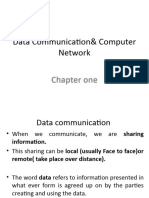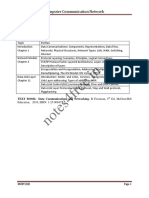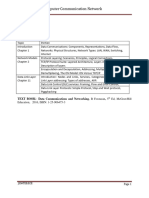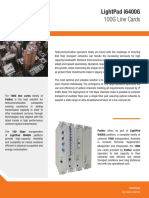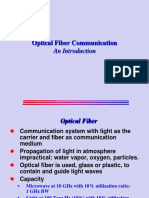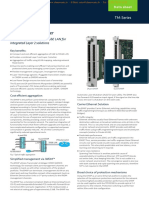1
Virtual Classes Notes
ACADEMIC PROGRAMME: BACHELOR OF SCIENCE IN COMPUTER SCIENCE
COURSE CODE AND TITLE: BSCS 302 – DATA COMMUNICATION AND NETWORKS
LECTURER’S NAME: PETER SIELE
LECTURER’S CONTACTS: Phone No.: 0711707689 Email: peter.siele@gretsauniversity.ac.ke
BSCS 302: DATA COMMUNICATIONS AND NETWORKS – LECTURE NOTES
OVERVIEW DATA COMMUNICATIONS AND NETWORKING
DATA COMMUNICATIONS
Data communications are the exchange of data between two devices via some form of
transmission medium such as a wired or wireless.
For data communications to occur, the communicating devices must be part of a
communication system made up of combination of hardware and software.
The effectiveness of a data communications system depends on four fundamental
characteristics: delivery, accuracy and timeliness.
1. Delivery: The system must deliver data to the correct destination. Data must be received by the
intended device or user and only by that device or user.
2. Accuracy: The system must deliver the data accurately. Data that have been altered in
transmission and left uncorrected are unusable.
3. Timeliness: The system must deliver data in a timely manner. Data delivered late are useless.
Data delivering in the same order that they are produced, and without significant delay. This
kind of delivery is called realtime transmission.
COMPONENTS OF A DATA COMMUNICATIONS SYSTEM
A data communications system has five components as follows;
1. Message. The message is the information (data) to be communicated. Popular forms of
information include text, numbers, pictures, audio, and video.
2. Sender. The sender is the device that sends the data message. It can be a computer,
workstation, telephone handset, video camera, and so on.
3. Receiver. The receiver is the device that receives the message. It can be a computer,
workstation, telephone handset, television, and so on.
4. Transmission medium. The transmission medium is the physical path/air by which a message
travels from sender to receiver. Some examples of transmission media include twisted-pair
wire, coaxial cable, fiber-optic cable, and radio waves.
5. Protocol. A protocol is a set of rules that govern data communications. It represents an
agreement between the communicating devices. It defines how it is communicated, when
communicated and what communicated. Key elements of protocols are timing, syntax and
semantics. Without a protocol, two devices may be connected but not communicating.
DATA REPRESENTATION
Information today comes in different forms such as text, numbers, images, audio, and video.
1. Text: In data communications, text is represented as a bit pattern, a sequence of bits (0s or 1s).
Page 1 of 15
�2
Virtual Classes Notes
2. Numbers: Numbers are also represented by bit patterns. However, a code such as ASCII is not
used to represent number; the number is directly converted to a binary number to simplify
mathematical operations.
3. Images: Images are also represented by bit patterns. In its simplest form, an image is composed
of matrix of pixels (picture elements), where each pixel is a small dot.
4. Audio: Audio refers to the recording or broadcasting of sound or music.
5. Video: Video refers to the recording or broadcasting of a picture or movie.
COMPUTER NETWORKS
A network is a set of devices/node connected by communication links.
Computers/devices on network are called nodes. Connecting medium are either physical
medium i.e. wire/cable or wireless medium (i.e. through radio waves).
Best known computer network is Internet.
NETWORK CRITERIA
A network must be able to meet a certain number of criteria. The most important of these are
performance, reliability and security.
Performance can be measured in many ways, including transit time and response
time.
In addition to accuracy of delivery, network reliability is measured by the frequency of
failure, the time it takes a link to recover from a failure, and the network's robustness in a catastrophe.
Network security issues include protecting data from unauthorized access, protecting,
from damage and development, and implementing policies and procedures for recovery from breaches
and lost data.
SIGNALS
One of the major concerns of the physical layer lies in moving data in the form of electromagnetic
signals across a transmission medium.
Analog and Digital
An analog signal is any continuous signal for which the time varying feature (variable) of the signal is
a representation of some other time varying quantity.
A digital signal is a chemical signal that is a representation of a sequence of discrete values (a
quantified discrete-time signal), for example of arbitrary bit stream.
A digital signal that is generated by means of a digital modulation method (digital pass band
transmission), produced by a modem.
Page 2 of 15
�3
Virtual Classes Notes
Analog data, such as the sounds made by a human voice, take on continuous values. When someone
speaks, an analog wave is created in the air. This can be captured by a microphone and converted to an
analog
signal or
sampled
and
converte
d to a
digital
signal.
Digital
data take
on
discrete
values.
Periodic and Non-periodic Signals
Both analog and digital signals can take one of two forms: periodic or non-periodic. In data
communications, we commonly use periodic analog signals
Periodic Analog Signals
Periodic Signals are signals that repeat themselves after a certain amount of time.
A periodic signal completes a pattern within a measurable time frame, called a period, and
repeats that pattern over subsequent identical periods.
The completion of one full pattern is called a cycle
The sine wave is the most fundamental form of a periodic analog signal.
The peak amplitude of a signal is the absolute value of its highest intensity.
Period refers to the amount of time, in seconds, a signal needs to complete 1 cycle.
Frequency refers to the number of periods in I s.
Page 3 of 15
�4
Virtual Classes Notes
PHASE
frequency.
BIT RATE
Most digital signals are non-periodic, and thus period and frequency are not appropriate characteristics.
Another term-bit rate (instead frequency)-is used to describe digital signals, so bandwidth of the digital
signal is measured in bit rate. The bit rate is the number of bits sent in 1s, expressed in bits per second
(bps).
Example 1
Assume we need to download text documents at the rate of 100 pages per minute. What is the
required bit rate of the channel?
Solution
A page is an average of 24 lines with 80 characters in each line. If we assume that one
Character requires 8 bits, the bit rate is
100 x 24 x 80 x 8 =1,636,000 bps =1.636 Mbps
WAVELENGTH
Page 4 of 15
�5
Virtual Classes Notes
Wavelength is the distance between identical points in the adjacent cycles of a waveform signal
propagated in space or along a wire.
Or it is the distance between one peak of a wave to the next corresponding peak, or between any two
adjacent corresponding points.
Wavelength binds the period or the frequency of a simple sine wave to the propagation speed of the
medium.
Wavelength =propagation speed x period=propagation speed/frequency
Bandwidth
The term Bandwidth defines the net bit rate, channel capacity, or the maximum throughput of a
logical or physical communication path in a communication system.
The bandwidth in analog signal is normally a difference between two numbers i.e the difference
between the highest and the lowest frequencies contained in that signal.
MODE OF DATA FLOW OR TRANSMISSION MODE
The transmission mode is the direction of the exchanges where the number of bits sent simultaneously.
Communication between two devices can be a mode of simplex, half-duplex, or full-duplex.
Simplex: In simplex mode, the communication is unidirectional, as on a one-way street. One of the
simplest examples is monitor keyboard communication, where keyboard only introduce input and
monitor can only display output
Page 5 of 15
�6
Virtual Classes Notes
-Duplex: In half-duplex mode, each station can both transmit and receive, but not at the same
time. When one device is sending, other can only receive and vice versa. Its examples are walkie-
talkies
-
Duplex
: In
full-
duplex
mode
both
stations
can
transmi
t and
receive
simulta
neously. The full-duplex mode is like a two-way street with traffic flowing in both directions at the
same time. Common example is the telephone network where both talk and listen possible at same
time
DIGITAL TRANSMISSION
Page 6 of 15
�7
Virtual Classes Notes
TRANSMISSION MODE
The transmission of data from one device to another is the wiring, and of primary concern when we are
considering the wiring is the data stream. The transmission of binary data (0 and 1) across a link can be
accomplished in either parallel or serial mode.
In parallel mode, multiple bits are sent with each clock tick.
In serial mode, 1 bit is sent with each clock tick. While there is only one way to send parallel
data, there are three sub classes of serial transmission: asynchronous, synchronous, and
isochronous.
PARA
LLEL
TRANS
MISSI
ON
Binary
data,
consisti
ng of 1s
and 0s,
may be
organiz
ed into
groups
of n bits
each. Computers produce and consume data in groups of bits. By grouping, we can send data n bits at a
time instead of 1. This is called parallel transmission.
Page 7 of 15
�8
Virtual Classes Notes
؎ The mechanism for parallel transmission is a conceptually simple one: Use n lines to send n
bits at one time.
؎ That way each bit has its own wire, and all n bits of one group can be transmitted with each
clock tick from one device to another.
؎ The advantage of parallel transmission is speed.
؎ That is parallel transmission can increase the transfer speed by a factor of n over serial
transmission.
s n communication lines
just to transmit the data stream. Because this is expensive, parallel transmission is usually limited to
short distances.
SERIAL TRANSMISSION
nel rather
than n to transmit data between two communicating devices.
Page 8 of 15
�9
Virtual Classes Notes
serial transmission reduces the cost of transmission over parallel by roughly a factor of n. Since
communication within devices is parallel, conversion devices are required at the interface between the
sender and the line (parallel-to-serial) and between the line and the receiver (serial-to-parallel).
one of two ways: asynchronous and synchronous.
ASYNCHRONOUS
∞ Asynchronous transmission is so named because the timing of a signal is not important.
Instead, information is received and translated by agreed upon patterns.
∞ Patterns are based on grouping the bit stream into bytes.
∞ Each group, usually 8 bits, is sent along the link as a unit.
∞ The sending system handles each group independently, relaying it to the link whenever ready,
without regard to a timer. Without synchronization, the receiver cannot use timing to predict
when the next group will arrive.
∞ To alert the receiver to the arrival of a new group, therefore, an extra bit is added to the
beginning of each byte.
∞ This bit, usually a 0, is called the start bit. To let the receiver, know that the byte is finished, 1
or more additional bits are appended to the end of the byte. These bits, usually 1s, are called
stop bits.
∞ The start and stop bits and the gap alert the receiver to the beginning and end of each byte
allow it to synchronize with the data stream.
∞ This mechanism is called asynchronous because, at the byte level, the sender and receiver do
not have to be synchronized.
∞ But within each byte, the receiver must still be synchronized with the incoming bit stream.
Page 9 of 15
�1
Virtual Classes Notes
SYNCHRONOUS TRANSMISSION
∞ In synchronous transmission, the bit stream is combined into longer "frames," which may
contain multiple bytes.
∞ Each byte is introduced onto the transmission link without a gap between it and the next one.
∞ It is left to the receiver to separate the bit stream into bytes for decoding purposes.
∞ In other words, data are transmitted as an unbroken string of 1s and 0s, and the receiver
separates that string into the bytes, or characters, it needs to reconstruct the information.
∞ The advantage of synchronous transmission is speed.
∞ With no extra bits or gaps to introduce at the sending end and remove at the receiving end, and,
by extension, with fewer bits to move across the link.
∞ Synchronous transmission is faster than asynchronous transmission.
∞ For this reason, it is more useful for high-speed applications such as the transmission of data
from one computer to another.
TRANSMISSION IMPAIRMENT
erfect.
the medium.
interruption).
Three causes of impairment are:
Attenuation,
Distortion,
Noise
Attenuation:
or strength.
electrical energy in the signal is converted to heat.
Distortion
s that the signal changes its form or shape.
Differences in delay may create a difference in phase if the delay is not exactly the same as the period
duration.
Noise
Page 10 of 15
�1
Virtual Classes Notes
corrupt the signal. Below figure shows the effect of noise on a signal.
MULTIPLEXING
There are two broad categories of bandwidth utilization(wise use of given bandwidths): multiplexing
and spreading.
In multiplexing, our goal is efficiency where, we combine several channels with low bandwidth
together into one with large bandwidth.
In spreading, our goals are privacy and anti-jamming where, we expand the bandwidth of a channel to
insert redundancy, which is necessary to achieve these goals of accuracy.
It combines multiple signals (analog or digital) for transmission over a single line or media.
A common type of multiplexing combines several low-speed signals for transmission over a
single high-speed connection.
Multiplexing is done by using a device called multiplexer (MUX) that combines n input lines to
generate one output line i.e. (many to one). Therefore multiplexer (MUX) has several inputs
and one output.
At the receiving end, a device called demultiplexer (DEMUX) is used that separates signal into
its component signals. So DEMUX has one input and several outputs.
Multiplexers and de-multiplexers are used to convert multiple signals into one signal.
link refers to the physical path. The word channel refers to the portion of a
link that carries a transmission between a given pair of lines. One link can have many (n) channels.
Multiplexing techniques can be categorized into the following three types:
Page 11 of 15
�1
Virtual Classes Notes
Frequency-division multiplexing (FDM)
Example: A very common application of FDM is AM and FM radio broadcasting. Radio uses the air
as the transmission medium. A special band from 530 to 1700 kHz is assigned to AM radio.
Signals generated by each sending device modulate different carrier frequencies. These modulated
signals are then combined into a single composite signal that can be transported by the link.
Channels can be separated by strips of unused bandwidth called guard bands to prevent signals
from overlapping.
Multiplexing Process
Each source generates a signal of a similar frequency range.
Inside the multiplexer, these similar signals modulates different carrier frequencies (f1,f2 and f3).
The resulting modulated signals are then combined into a single composite signal that is sent out
over a media link that has enough bandwidth to accommodate it.
Page 12 of 15
�1
Virtual Classes Notes
Wavelength-Division Multiplexing
The basic idea is that combine multiple light sources into one single light at the multiplexer and
do the reverse at the de multiplexer.
Wavelength-division multiplexing (WDM) is designed to use the high-data rate capability of
fiber-optic cable.
The optical fiber data rate is higher than the data rate of other metallic transmission cable.
Using a fiber-optic cable for one single line wastes the available bandwidth.
Concept of WDM is same as FDM, except that the multiplexing and de multiplexing, here
involve optical signals transmitted through fiber-optic channels.
Very narrow bands of light from different sources are combined to make a wider band of light.
Page 13 of 15
�1
Virtual Classes Notes
TIME-DIVISION MULTIPLEXING (TDM)
It is also called synchronous TDM, which is commonly used for multiplexing digitized voice
stream.
The users take turns using the entire channel for short burst of time and that allows several
connections to share the high bandwidth of a line.
Each connection occupies a portion of time in the link.
Page 14 of 15
�1
Virtual Classes Notes
In synchronous TDM, the data flow of each input connection is divided into units, where each input
occupies one input time slot.
Page 15 of 15



















